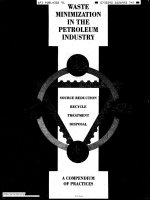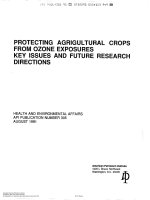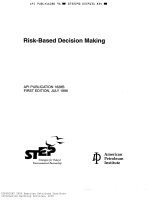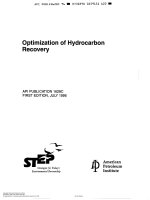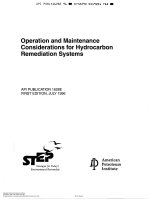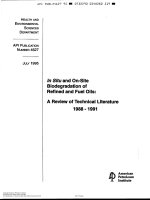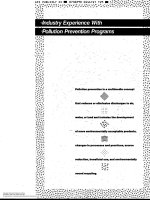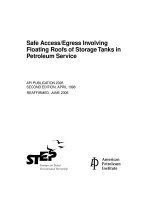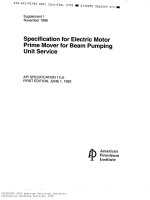Api publ 1571 1996 scan (american petroleum institute)
Bạn đang xem bản rút gọn của tài liệu. Xem và tải ngay bản đầy đủ của tài liệu tại đây (459.48 KB, 17 trang )
A P I PUBLx1571 76
0732290 0 5 5 0 7 5 0 Tbb
=
Diesel Fuel
I
Questions & Answers
1
For Highway and Off-Highway Use
API PUBLICATION 15 7 1
FOURTH EDITION, JANUARY 1996
Copyright American Petroleum Institute
Provided by IHS under license with API
No reproduction or networking permitted without license from IHS
--`,,-`-`,,`,,`,`,,`---
I
American
Petroleum
Institute
Not for Resale
~~~
A P I PUBL*157L 96
0 7 3 2 2 9 0 0550753 9 T 2
Diesel Fuel for Highway
and Off-Highway Use
Table of Contents
Grades of Diesel Fuel ..........................
1- 6
Properties and Specifications ................7
- 13
Low-Temperature Operability ............14 - 18
19 - 23
Additives ..........................................
24 - 25
--`,,-`-`,,`,,`,`,,`---
Performance Issues ............................
Additional Information..............................
Copyright American Petroleum Institute
Provided by IHS under license with API
No reproduction or networking permitted without license from IHS
26
Not for Resale
~
ApI P U B L + L 5 7 L 9b
= 0732290 0550752 8 3 9
Grades of Diesel Fuel
1.
Q. What is diesel fuel?
A. Diesel fuel is principally a blend of petro-
--`,,-`-`,,`,,`,`,,`---
leum-derivedcompounds called middle
distillates(heavierthangasolinebut
lighter than lube oil) and
may or may not
contain additional additives. During the
operation of a diesel engine, diesel fuel is
injected into the compressed, high-temperature air in the combustion chamber
where it ignites spontaneously.
2.
Q. How many grades of diesel fuel
are there?
A. The American Society for Testingand
Materials(ASTM)inASTMStandard
Specification D 975 defines two grades of
low-sulfur diesel fuel for highway useNo. 1-D and No. 2-D. Three high-sulfur
grades of diesel fuel are specified for offhighway use-No.
1-D, No. 2-D, and
No. 4-D. Federal regulationsprohibit
the use of high-sulfur diesel fuelfor highway use. Federal regulations also require
fuel suppliers to add red dye to high-sulfur dieselfueland
to low-sulfur,taxexempt fuel.Californiaregulationsprohibit the use of high-sulfur diesel fuel in
all motor vehicles.
ASTMdescribesdieselfuelgrades
by
theirintendedprimaryapplication.
This is usually associated with the tendency for the fuel to vaporizeas follows:
Grade No. 1-D-includes
themost
volatiledieselfuelsfromkeroseneto
intermediate distillates. These fuels are
usually the lowest cloud and pour point
Copyright American Petroleum Institute
Provided by IHS under license with API
No reproduction or networking permitted without license from IHS
Not for Resale
~~
~~~~
~~~~~
A P I PUBL*1571 96
~
~~~~
~
fuelsavailable.Fuelsinthisclassification are suitable for use inhigh-speed
dieselenginesin services involving frequentand relatively widevariationsin
loads and speeds, such as in stop-and-go
busanddoor-to-dooroperations.These
fuelsare also for use whenabnormally
low
ambient
temperatures
may
be
encountered.
Grade No. 2-D-includes
--`,,-`-`,,`,,`,`,,`---
thedistillates of higher and wider boiling range
than the No. 1-D fuels. These fuels normally have higher specific gravity (more
dense) and higher cloud and pour points
than No. 1-D fuels. Thesefuelsare for
use in diesel engines carrying relatively
heavy loads at uniform speeds. They are
generally used in equipment that operate
in climates where cold starting and cold
fuelhandling are not severe problems
but can be winterized to operate at lower
temperatures. The No. 2-D grade is the
most common and is widely used to satisfy the majority of automotive-type and
heavy-duty-type
diesel
applications.
Examplesareautomobiles,long-haul
trucks,constructionequipment,total
energy units, farm tractors, and railroad
diesels.
Grade No. 4-D-includes
fuel oil con-
tainingdistillatesthatareharderto
vaporizeandmoreviscous,
as well as
someblendswithresidualfueloils.
These fuels are for use in low- and medium-speed
diesel
engines
in
services
involving sustained loads at substantially
constant speeds and are used mostly in
large, high output diesels for stationary
power plants and ships.
Copyright American Petroleum Institute
Provided by IHS under license with API
No reproduction or networking permitted without license from IHS
~~~~~~
0732290
0550753
775
Not for Resale
3.
Q. Why was the sulfur content of
diesel fuel lowered?
A. Low-sulfurdieselfuels
(less than 0.05
mass percent) are required by federal regulations for highway vehicles to ensure
that these vehicles will meet particulate
emissions standards to improve the quality of the air we breathe. In California,
properties of vehicular diesel fuel are also
controlled to help reduce smog.
4.
Q. Is diesel fuel sulfur content
important to engine life?
A. Dieselfuelsulfur content may be important to enginelife if it is above the current
ASTM limit of 0.50 mass percent for
high-sulfur fuels.Fuel
sulfurcontent
above that level can increase piston ring
and cylinderwear unless the type of lubricatingoilorthe
oil draininterval
is
changed to accommodate higher sulfur
levels. Suppliers will recommend specific
lubricants for use with higher sulfurfuels.
Q. Why can’t all dieselfuelin
U.S. be made to
one
uniform
standard?
5.
the
A. The properties of diesel fuels vary with the
crude oil from which they are made and the
processing they undergo, as well as the additives used (if any). In addition, engine fuel
requirements change with geographic area
and climates. Winter operation in colder,
northern states imposes more severe requirements thanfor the warmer parts of the counCopyright American Petroleum Institute
Provided by IHS under license with API
No reproduction or networking permitted without license from IHS
--`,,-`-`,,`,,`,`,,`---
Not for Resale
try. In cold areas, winterized diesel fuels are
marketed by many manufacturers to offer a
fuel that will performbetter in cold weather.
To make all diesel fuel meetthe most severe
standard would increasethe cost of fuelto all
customers and would not
be energy efficient.
Most suppliers provide diesel fuel meeting
the requirements of ASTM D 975.
A. Most engines are designed to operate on
ASTM No. 2-D grade, but some diesel
engines in stop-and-go service require
No. 1-D diesel fuels in order to perform
satisfactorily. Follow the recommendations of the engine manufacturer and a
reputable fuel supplierwho recognizes
that some fuels may have special or additive-derived quality features.
Properties and Specifications
7.
Q. What specification requirements
of diesel fuel should concern
me?
A. Cetanenumber(ignitionquality),
cleanliness,low-temperatureoperability,and
stability are the diesel fuel requirements
of principal concern.
8.
Q. What is the significance of each
of these requirements?
A. Cetane number is
the ease
with which the &el' is ignited in an engine
and is most significant in relation to low-
Copyright American Petroleum Institute
Provided by IHS under license with API
No reproduction or networking permitted without license from IHS
a measureof
Not for Resale
--`,,-`-`,,`,,`,`,,`---
6.
Q. How do I know which grade touse?
--`,,-`-`,,`,,`,`,,`---
temperaturestartability,warm-up,and
smooth, even combustion. The cetane number of the fuel should meet theengine manufacturer’s minimum recommendation for
the type of service. A cetane number higherthanrequired
does not
materially
improve engine efficiency or operation.
Most engine manufacturers recommend
diesel fuelswith a cetane number of at least
40. Dieselfuelssold
by reputable marketers meet or exceed this requirement.
Cleanliness refers to the absence of water
and particulate contamination. This characteristic is important because dirt and
water can plug fuel filters and cause severe
damagetothe
fuel
injection
system
of fuel
because of the closetolerances
pumps and injectors. All diesel engine
manufacturers equiptheir engines with
fuel filters to protect the fuel delivery system.Thesefiltersshould
be replaced
according to themanufacturer’s recommendations. Some manufacturers also provide
filters with drain valves and recommend
periodic draining of any water that may
accumulate from condensation and careless
handling in storage or vehicle tanks.
Low-temperature operabilityis the ability
of the fuel to flow and to be pumped through
diesel fuel system filters
without pluggingat
low temperatures. Filter plugging dueto the
presence of wax crystals in the fuel can be
estimated by measuring the cloud point
temperature and by various fluidity and filterability tests. (See API Publication 1577,
“Winter Diesel-Questions andAnswers,”
for additional information.)
Stability is the termused to describe a fuel’s
resistance to the formation of gums and
insoluble oxidation products. Fuels with
poor oxidation stability contain insoluble
Copyright American Petroleum Institute
Provided by IHS under license with API
No reproduction or networking permitted without license from IHS
Not for Resale
~~
A P I PUBLU1571 9b
~
0732270 0550757 310 M
particles thatcahplugfuelfilters.This
maya’lead to decreased engine performance
or engine stalling from fuel starvation.
f l ,
9.
Q. How is the cetane number of a
diesel fuel measured?
A. The cetane number of
a diesel fuel is
determined by comparing its ignitioncharacteristics under prescribed operating conditions using standard reference fuels in a
single-cylinder laboratory engine.
10.
Q. What does the heat energy or Btu
content of a diesel fuel mean?
A. The higher the fuel’s heat of combustion,
the more power will be derived from each
gallon of fuel consumed. The energy content of diesel fuel is defined by the amount
of energy stored inone gallon. Energycontent is measured in British thermal units
(Btu) per gallon andis related to the fuel’s
specific gravity and the temperature range
at which it vaporizes. The Btu content per
unit volume increases as the specific gravity increases. The Btu contentof a unit volume (gallon or liter)of diesel fuel is higher
than that of gasoline, and the Btu content
of No. 2-D diesel fuel is generally higher
than that of No. 1-D diesel fuel.
11.
Q. What is diesel fuel lubricity?
A. Diesel fuel lubricity is a measure of diesel
fuel’s ability to reducewear on contacting
solid surfaces found in some fuel pumps
Copyright American Petroleum Institute
Provided by IHS under license with API
No reproduction or networking permitted without license from IHS
Not for Resale
--`,,-`-`,,`,,`,`,,`---
API PUBL*L57L 96
0732290 0550758 257
andinjectors.Inthe
case ofdiesel
engines, some fuel pumps and fuel injectors are lubricated by the fuel, so lubricity is a measure of a diesel fuel's ability to
prevent wear in these parts.
12.
Q. What is the significance of
diesel fuel viscosity?
A. Diesel fuel viscosity affects fuel delivery rate
and the ability of the fuel to atomize. Also,
the viscosity of diesel he1 can protect against
wear in fuel pumps designed to be lubricated by the fuel. Follow the recommendations
of your engine's manufacturer for the grades
of diesel fuel providing an acceptable viscosity range for your type of use.
13.
Q. What is flash point?
tureatwhich
vapors formed above the
surface of the liquid fuel will ignite when
exposed to open flames under prescribed
laboratory test conditions. Flash point has
a negligible effect on engine performance
but can be a significant fire hazard in the
handling and storage of fuel. A low-flash
point temperature may indicate contamination of the diesel fuel with gasoline or
other volatile materials such as alcohols.
Low Temperature Operability
14.
Q. What is winter diesel fuel?
A. A winter diesel fuel is a No. 1-D or a No.
2-D fuel that has been modified to permit its use at lower ambienttemperaCopyright American Petroleum Institute
Provided by IHS under license with API
No reproduction or networking permitted without license from IHS
Not for Resale
--`,,-`-`,,`,,`,`,,`---
A. The flash point of a fuel is the tempera-
~
~
~~
A P I PUBLxII571 96
~
~~
~~
~
~~
~
0 7 3 2 2 9005 5 0 7 5 9
193
tures.Typicallythisimprovement
is
accomplished by blending No. 1-D with
No. 2-D.Thefinalblend
has a lower
cloud point than No. 2-D; therefore, wax
crystals or gelling occurs at a lower temperature than for No. 2-D. Additives also
can improve the low-temperature performance of No. 2-D. Additional information on winter diesel fuel is found in API
Publication
1577,
“Winter
DieselQuestions and Answers.”
CAUTION: Gasoline should not be used
to dilute diesel fuel because the mixture
has much
greater
flammability
and
explosive potential than either gasoline or
diesel fuel alone.
15.
Q. What factors affect low temperature performance?
A. Manyfactors,such
as battery condition,
cetane number, and injector settings, can
affectlow temperature starting and performance.However, the most important fuel
characteristic is the cloud point temperature.
16.
Q. Why are the cloudpoint and
pourpointtemperaturesimportant?
A. Cloud point is thetemperatureat
Copyright American Petroleum Institute
Provided by IHS under license with API
No reproduction or networking permitted without license from IHS
--`,,-`-`,,`,,`,`,,`---
which
wax crystals first appear in the fuel. As the
temperature drops below the cloud point,
the wax crystals continue to grow andcan
resultinfilterpluggingandengine
stalling or non-starting. Generally, No. 1D and winterized No. 2-D grades have
lower cloudpointsthanGrade
No. 2-D
fuel. The pour point,generally lower than
Not for Resale
the cloud point, is 3% (5OF) higher than the
temperature at ,which the fuel will no JQnger
flow under prescribed laboratory test conditions. Petroleum manufacturers, on the basis
of area temperature studies, manufacture
and distribute fuels with cloud points and
pour points that have been adjusted so that
the fuel should' operate satisfactorily in the
various localities concerned.
17.
Q. How can I improve low temperatureoperabilitybyequipment
modification?
-.-
A. Low temperatureoperabilitycanbe
improved by properlyinstallingtank
heaters, fuel-line heaters, and heated fuel
filters.Manyequipmentmanufacturers
offer these as options and, in some cases,
as standard equipment.
--`,,-`-`,,`,,`,`,,`---
Low temperatureoperability of vehicles
notequippedwith
fuel heating devices
must rely on a fuel's cold-flow characteristics for satisfactory operation. If vehicles are
equipped with fuel-heating devices, good
operability maybe obtained at fuel tank
temperatures below the cloud point.
18.
Q. Are diesel cold-startingfluids
effective?
A. When properly used, diesel cold-starting
fluids can be a valuable aid to cold starting. These fluids are usually composed of
a mixture of ethyl ether and a blend of
solvent materials pressurized with carbon
dioxide (CO,). For effective response, the
secondary component combined with the
ethershould
have highvolatilityand
Copyright American Petroleum Institute
Provided by IHS under license with API
No reproduction or networking permitted without license from IHS
Not for Resale
high-cetanequalities.
Care should be
exercised, however, to avoid overdosing
an engine with starting fluids, as severe
mechanical damage can result.
CAUTION: Theengine
manufacturer’s
recommendationsmust
be referred to
before using any starting aids.
Performance Issues
19.
Q. Why do diesel engines smoke?
A. Diesel engine smoke is causedby incomplete combustion. White smoke is caused
by tiny dropletsof unburned fuel resulting
from engine misfiring at low temperature.
This smoke shoulddisappear as the engine
warms up. Black smoke could be caused
by a faulty injector, insufficient air, and
overloading and/or overfueling the engine.
Blue-gray smoke is the result of burning
lubricating oil and isan indication the
engine is in poor mechanical condition.
--`,,-`-`,,`,,`,`,,`---
20.
Q. How does water get into diesel
fuel and what problems can it
cause?
A. Water gets intodiesel fuel storage and vehicle tanks in several ways-by condensation,
during transportation, by leakage through
faulty fill pipesor vents, and by carelesshandling. Water can cause injector nozzle and
pump corrosion, bacteria and fungi growth,
and fuel filter pluggingwith
materials
resulting from corrosion or
microbial
growth. Both vehicleand
storage tanks
should be checked frequently for water and
drained or pumped as necessary. In extreme
Copyright American Petroleum Institute
Provided by IHS under license with API
No reproduction or networking permitted without license from IHS
Not for Resale
~~
~
~
API P U B L 8 1 5 7 L 9067 3 2 2 9005 5 0 7 6 2
~~
~~
788
cases, biocides may be required to control
bacterial growth.
In cold northern winters, ice formation in
fuels containing water creates severe fuel
line
and
filter
plugging
problems.
Regularly removing the wateris the most
effective means of preventing this problem; however, small quantities of alcohol
maybe used onanemergency basis to
preventfuellineandfilter
freeze-ups.
(See Question 24, Item 5.)
21.
Q. What are some fuel-handling
causes of poor diesel engine
performance?
A. Contamination of fuel by water and dirt
--`,,-`-`,,`,,`,`,,`---
entering the fuel as a result of careless fuel
handling may cause poor diesel engine performance. Extreme care must be exercised.
Fuel-tank caps, dispensing nozzles, and
hoses should be kept clean toeliminate
potential sources
of
contamination.
Regularlyremovingwaterfromstorage
tanks, vehicle fuel tanks, and filterbowls is
important. Dry storage systems willreduce
fuel emulsion problems, injection system
corrosion, and microbial growth.
22.
€2. Does diesel fuel color affect
performance?
A. No. There is no relationship between natural diesel fuel color and such desirable diesel
fuel qualities as heat content, viscosity,
cloud point, cetane number, or distillation
range. Diesel fuel color varieswith thecrude
source, refinery methods, and the use of
dyes. However, if the fuelcolor darkens
Copyright American Petroleum Institute
Provided by IHS under license with API
No reproduction or networking permitted without license from IHS
Not for Resale
~
A P I PUBLxL57L 9 6
appreciablyduringstorage,this
could
indicate oxidation and/or contamination
from dirt, water, or other sources, which
can cause operating problems.
23.
Q. What effect does blending used
lubricating oil into diesel fuel
have on engine performance
and fuel quality?
A. You should consult your engine manufacturerregardingtheblending
of used
lubricating oils into dieselfuel.
This
practice may adversely affect fuel quality
features and could lead to fuel system and
piston deposits, increased exhaust emissions, and fuel-filter plugging. Thispracticemay also result inthe dieselfuel
being outof compliance with state orfederal regulations or other specifications.
Additives
24.
Q. What additives are normally
used in diesel fuels and for what
purposes?
A. If required, fuel suppliers generally blend
the necessary additives into the fuel before
distribution. It should be noted that most
engine manufacturers recommend against
the use of additives other thanthose added
by fuel suppliers. The following types of
additives may be used to enhance particular fuel properties. Not all fuel will contain any or all of these additives.
1. Oxidationinhibitorsareusedto
reduce the formation of gums and insoluble residues that can clog fuel filters.
--`,,-`-`,,`,,`,`,,`---
Copyright American Petroleum Institute
Provided by IHS under license with API
No reproduction or networking permitted without license from IHS
~~
0732290 0550763 b L 4 H
Not for Resale
~
~~
A p Ip U B L x 1 5 7 1
96
=
~~
~~~
07312270 05507b4550
--`,,-`-`,,`,,`,`,,`---
2. Ignition
quality
(cetane
number)
improvers are used to increase the cetane
number when the base fuel cetane does
not meet requirements.
3. Detergent-dispersantadditiveshelp
keep fuel-insoluble materials in suspension
and are helpful in maintaining a clean
engine and fuel delivery system.
4. Rust preventives and metal deactivators are used when storage, handling, or
shipping conditions warrant.
5. Anti-icing additives, such as alcohols, may
be used in very coldareas in winter to help prevent ice fiom plugging fuel lines and filters.
CAUTION Do not use excessive amounts
ofalcoholsincealcohollowers
the cetane
number and flash point and can increase corrosive wear on the fuel pump and injectors.
In all cases, followthe manufacturer’s recommended maximum dosage. Never use more
than one pint (473 milliliters) of alcohol per
100 gallons (379 liters) of fuel. Manyengine
manufacturers specifically warn against
using alcohols because of the adverse effects
on pumps, pump seals, and flash point.
6. Cold-flow improvers, whenused selectively,
may permit operation at temperatures below
the cloudpoint temperature of the fuel in certaindiesel equipment. Effectivenessvaries
with crude oil sourceand refining techniques.
7. Biocides may be added to diesel fuel to
prevent
microbial
growth.
Microbial
growth instored fuel creates insoluble particles that can cause fuel-filter clogging.
8. Reddye is requiredto be addedto
high-sulfurandlow-sulfurtax-exempt
diesel fuel by federal regulations.
7. Lubricity additives may be used in certain applications to improve the lubricating ability of the fuel.
Copyright American Petroleum Institute
Provided by IHS under license with API
No reproduction or networking permitted without license from IHS
Not for Resale
~~
Fuel suppliers carefully weigh the benefits
and possible adverse effects of all of these
various additives in the fuel they market.
25.
Q. Can diesel fuel additives, such
as those offered by automotive
chemical manufacturers,
improve diesel fuel and/or
engine performance?
A. Many of the over-the-counter automotive
chemicals may provide some improvements, such as low-temperature flow and
cetane
performance.
However,
engine
manufacturers usually recommend against
using additives other than those added by
fuel suppliers.
Additional Information
26.
Q. Where can I get more information about diesel fuel?
A. Most petroleum companiesare happy to
answer inquiriesabouttheirproducts.
You can also write or telephone the
lowing organizations:
fol-
American Petroleum Institute
1220 L Street, NW
Washington, DC 20005
202-682-8000
Society of Automotive Engineers
400 Commonwealth Drive
Warrendale, Pennsylvania 15096
412-776-4841
American Society for Testing and Materials
100 Barr Harbor Drive
West Conshohocken, PA 19428
610-832-9500
--`,,-`-`,,`,,`,`,,`---
Copyright American Petroleum Institute
Provided by IHS under license with API
No reproduction or networking permitted without license from IHS
PG-01400-1/96--1OM
(1E)
Not for Resale
--`,,-`-`,,`,,`,`,,`---
American
Petroleum
Institute
Copyright American Petroleum Institute
Provided by IHS under license with API
No reproduction or networking permitted without license from IHS
1220 L Street, Northwest
Washington, D.C. 20005
202-682-8000
Order No. F157104
Not for Resale
